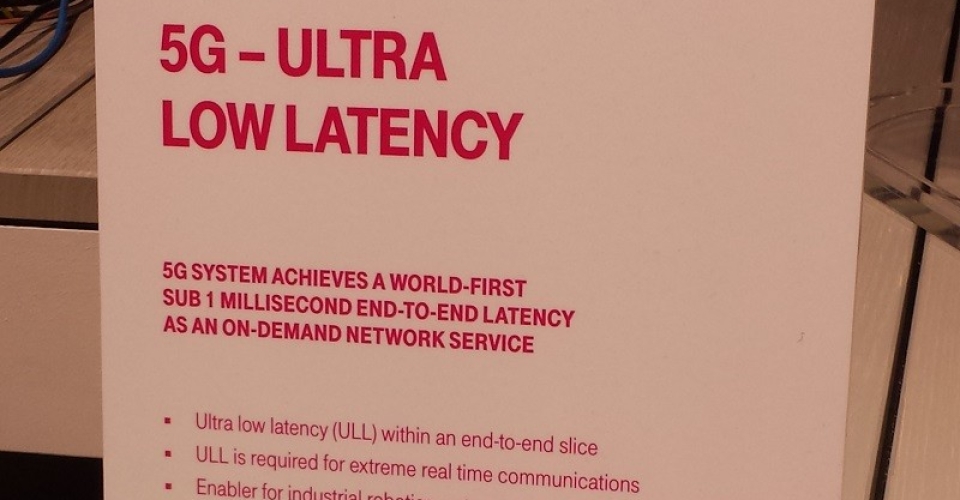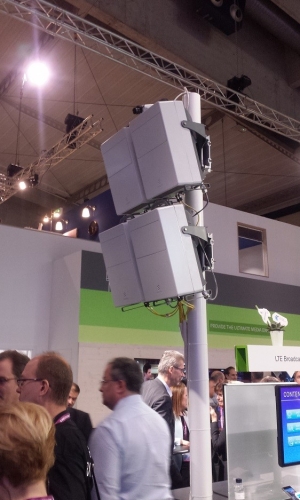There was, of course, a lot of hype around 5G this year, but was there much to show for all the noise on the show floor? Well, yes and no. There were some 5G “demos” that we shall draw a veil over, as it is kinder to say nothing when you have nothing nice to say. Others, like the Ericsson, Deutsche Telekom and NTT DoCoMo/Nokia demos, had more on offer in terms of test tech.
Some of the demos were sketchy at best. Concepts, perhaps. For instance. On the China Mobile booth the operator and Nokia were showing two robots juggling a ball on a rail. Despite its 5G label (and there were plenty of “5G robot” tweets going around), the demo staff told me there was nothing 5G about this demo – in the sense that there was no connectivity over any sort of pre or proto-5G infrastructure. The point of the demo was to show the difference between “zero” latency (what you can see here) and 90ms latency – which is more like the end-to-end norm in LTE networks. At the LTE latency, it took the robots a lot longer to get the ball under control. You’ll have to imagine that, I’m afraid as I didn’t film it. Still, robots though.
China Mobile Nokia Cloud Robot from The Mobile Network on Vimeo.
Here were some (sort of) self driving, autonomous cars. Nokia’s aim is to leverage its Mobile Edge Computing, intelligence-at-the-base-station technology, into one of the platforms that can provide very low level latency services in the network. The control of self-driving cars is one of those use cases, although V-2-V technologies that have nothing to do with the mobile network may in fact have more of a role to play here. Anyway, here is an autonomous car application that was fun to stare at for a few seconds.
Nokia 5G car demo from The Mobile Network on Vimeo.
Also with the robots was Deutsche Telekom, this time with a much more fully rounded out demo. Again, this time the robot was showing the difference between LTE and 5G latencies, and was in fact connected over a radio that was delivering “slices” of connectivity determined by a Huawei controller in the core network.
The demo was set up with three “slices”: a ULL (Ultra Low Latency) slice, an Ultra High Data Rate slice and a Mobile BroadBand (LTE) slice. The components of the demo were a Samsung radio, with edge functionality from Stanford University’s SoftRAN tech, controlled, as we said by that Huawei controller.
This was a nice demo as it actually had some real elements – radio, control. It’s a crude vision of “slicing”, but it is a demo. And with DT announcing that SoftRAN joined its 5G:haus incubation programme back in March – nice to see the tech in daylight.
So, here was the ULL use case. The pink ball represents the ULL slice – and is able to drop into the robot arm as it sweeps by because it is released in time by its controller. The chrome ball is released too late, as it is controlled over the MBB-LTE slice. 5G wins!
Deutsche Telekom 5G slicing demo from The Mobile Network on Vimeo.
Another nice demo was on the NTT DoCoMo booth. This MIMO demo showed beam forming and tracking using a 64 element antenna array connected to a test UE. As the UE was rolled gently sideways, the beam tracked the device, identifying the best beam to use. NTT DoCoMo had rigged up some VR goggles which visualised the “beam” in the air, so the viewer in the chair could watch the beam move as the UE moved. The test radio was supplied by Nokia, and was operating right up in the 70GHz band, achieving a throughput of 2Gbps to the individual UE, with an overall system bandwidth of 1GHz.
There was a similar but slightly more flashy demo of beam forming and tracking on the Ericsson booth. This demo connected two devices simultaneously, hence was a Multi User (or MU) MIMO demo, with one stationary UE and one mounted on rails, along which it actually moved a few metres. The demo used Ericsson’s 5G prototype access points, essentially four 128 arrays bolted together to make a 512 element array.
(Trivia: each of those boxes on the mast is one of Ericsson’s prototype field radios, as carried in this press stock shot. And the demonstrator at MWC was the same man as is in the photo.)
As the UE moved, the antennas were able to keep up simultaneous transmission of 25Gbps to both UEs. The demo used 800MHz channels on 15GHz trial spectrum.
A final one, PureLiFi, the company that is commercialising its take on Visible Light Communications, had moved its demo on a step or two from previous versions. Here it had a USB dongle about the size of a business card, that acted as a receiver for signals transmitted in the modulated light from an overhead LED light.
The demo had three Ethernet-connected access points, each serving a commercial LED light. The LED then transmits via light to the dongle, which acts as a modem into the PC/notebook. The blue square on the dongle is a visible light detector and receiver, while the circle is an IR LED that can send signal from the device to the light on the uplink. PureLiFi said each access point could in theory support 16 active users, and that each light in this set up provided about 10 square metres of coverage.
Not a demo, or 5G, but outside the media room was this JC Decaux advertising sign, integrated with a Huawei small cell and antenna. Decked in the Vodafone livery (there are in fact trials ongoing in the Netherlands with Vodafone and in the USA with Verizon), it was interesting to see as a commercial implementation of something that to date has been largely visible via press release. Of course, in real life the radio and antenna elements would not be visible.
And finally… SK Telecom’s central attraction was literally booth design as pun. VR is immersive, right, so let’s build a pretend submarine in which we can truly “immerse” the users. Positively drowning in literalism.
Also on SK Telecom’s booth was this slightly bleak dystopian vision – a live feed of a 5G base station and test UE sitting in a characterless room, staring at each other in what looks like eternal silence, while two PCs look on monitoring their interaction. “You’re not coming to the booth until you reach 50Gbps”. Let the base station and UE out of the lab, we say. Bring them to the yellow submarine. Let them join in the jamboree.


















